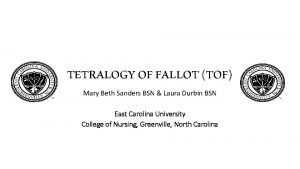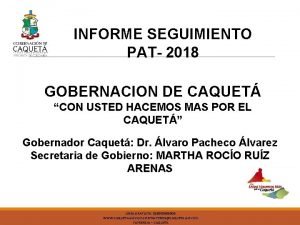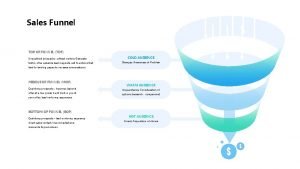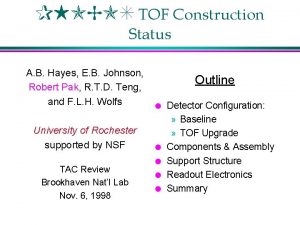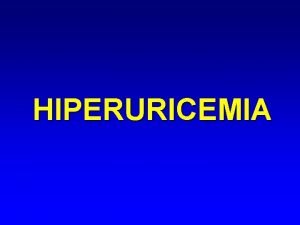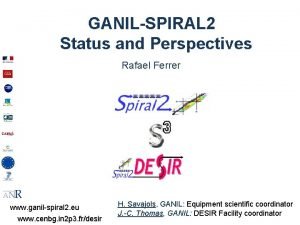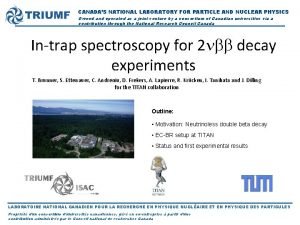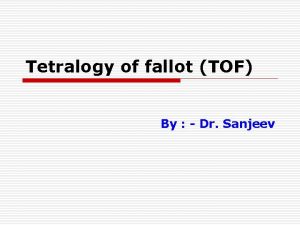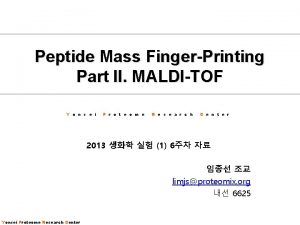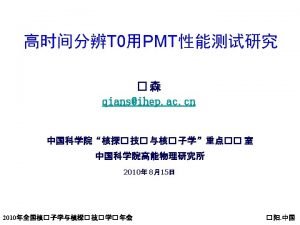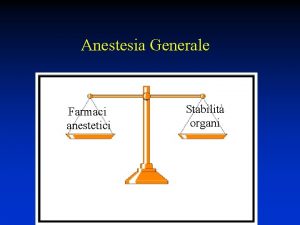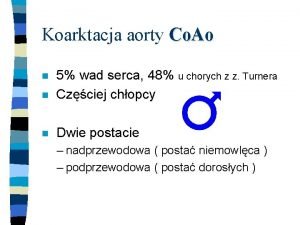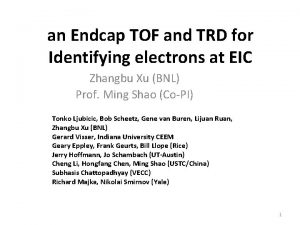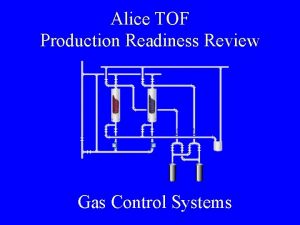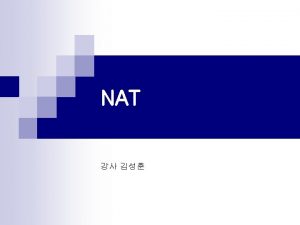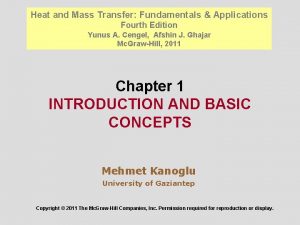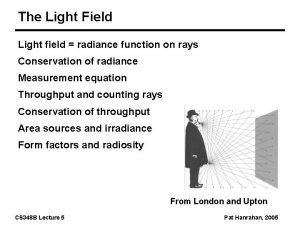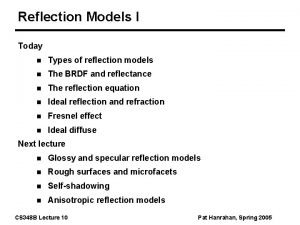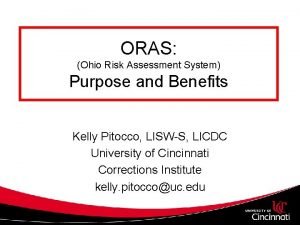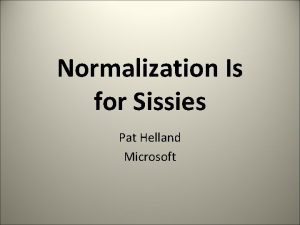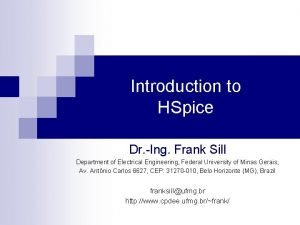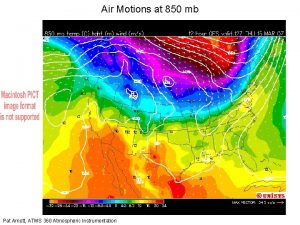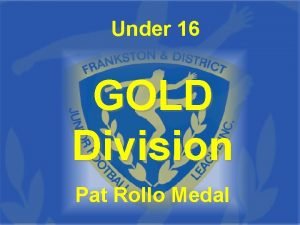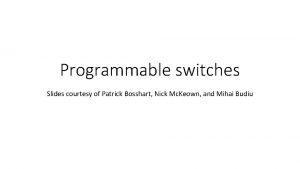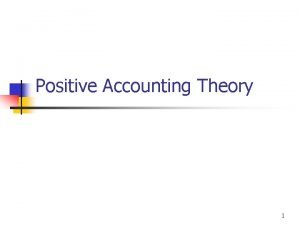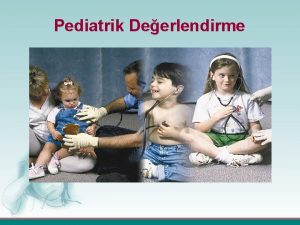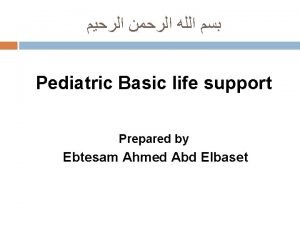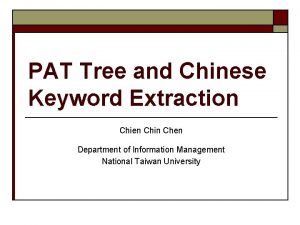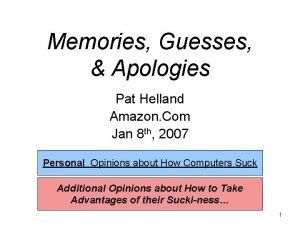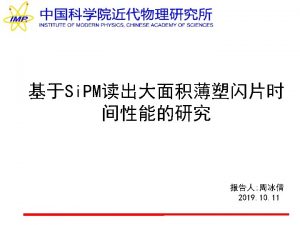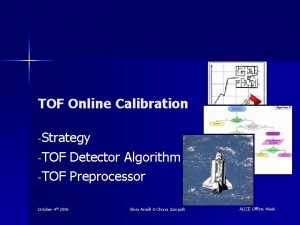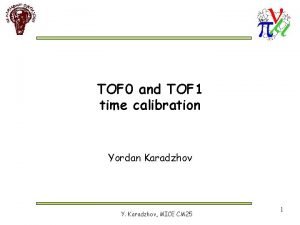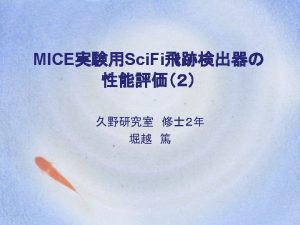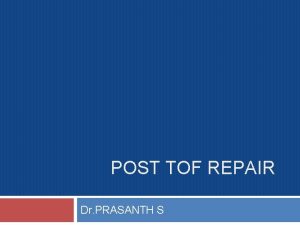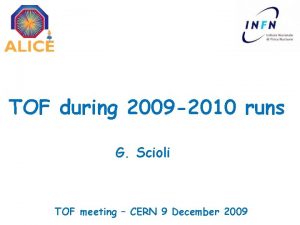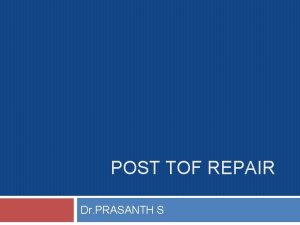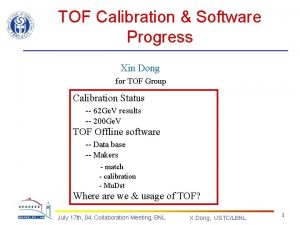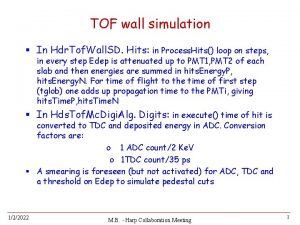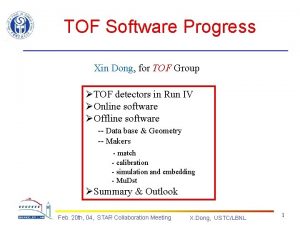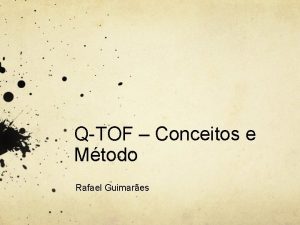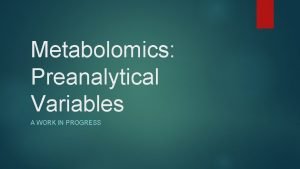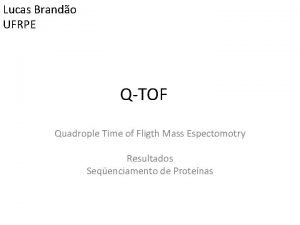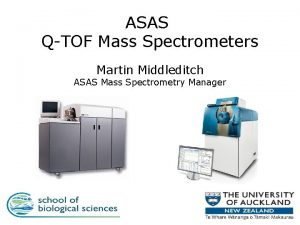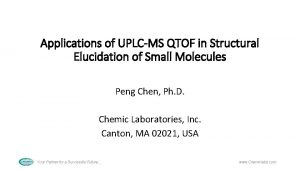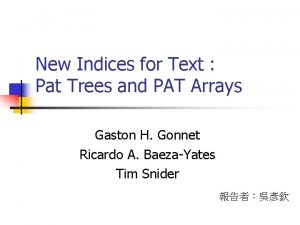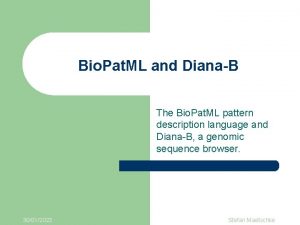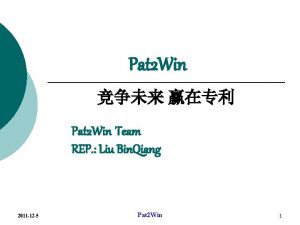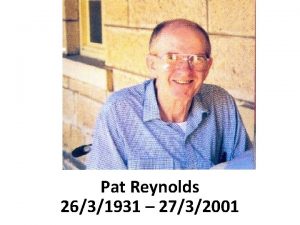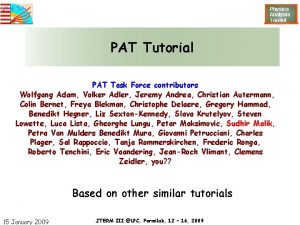Fundamentals of TOF and QTOF Dr Patrick Pat


















































- Slides: 50

Fundamentals of TOF and QTOF Dr. Patrick (Pat) Perkins R&D scientist Agilent Technologies Life Sciences and Chemical Analysis Santa Clara, CA TOF and QTOF Fundamentals Page 1 March 2007

Agenda Time-of-Flight (TOF) Mass Spectrometry basics • Mass measurement • Sources of variability in the measurement • Minimizing the variability in the measurement Quadrupole Time-of-Flight (QTOF) MS • Ion optics, collision cell design and performance TOF and QTOF Fundamentals 2 March 2007

Definitions Used With TOF m/z—”mass-to-charge ratio”. The mass of an ion divided by its charge, the actual result produced by all mass spectrometers. For ions with a single charge (most small molecules), this is its isotopic molecular weight plus any adduct (proton, sodium, …). Proteins and peptide ions are in general multiply-charged, and therefore additional math (deconvolution) is used to determine their molecular weights. oa—”orthogonal acceleration”. Ions are accelerated (“pulsed”) down the flight tube in a direction perpendicular to their entry into the TOF analyzer. This minimizes the effects of ion generation and transmission on the mass measurement. ppm—”parts-per-million”, a measure of the error in the experimental mass assignment, compared to the known (or theoretical) value. Resolution—a dimensionless value indicating the ability of the mass analyzer to separate (resolve) ions. Higher values mean better resolving power. Several definitions exist, but the most common is M/ M, the m/z value of the ion divided by its peakwidth expressed in m/z units. Transient—one packet of ions pulsed down the flight tube and detected. Data from many pulses, typically ~10, 000, are summed to create a spectrum. TOF and QTOF Fundamentals 3 March 2007

Basic Ideal TOF Mass Spectrometer KE = ½ m v 2 Detector v = d/t t = m½ * d/(2 KE)½ constant Ideally, to measure the mass, Measure the time and use d Vacuum m = A * t 2 Practically, V t = m½ * d/(2 KE)½ + t 0 2 constants m = A * (t – t 0)2 TOF and QTOF Fundamentals 4 March 2007

Sources of Variability in Measurement (Deviations from Ideality) Detector Vacuum d ? ? ? V TOF and QTOF Fundamentals 5 March 2007

Sources of Variability in Measurement (Deviations from Ideality) Ions don’t all start at the same plane in space relative to flight direction Detector Vacuum Ions aren’t sitting still and have different velocities relative to flight direction Temperature fluctuations change flight distance Voltage pulse is not instantaneous or of invariant shape Ions farther from voltage pulse element(s) obtain a higher velocity d Change in temperature/humidity alter pulse electronics ? ? ? Poor vacuum scatters ions Detector and/or method of detection alters arrival times V Inaccurate method(s) of locating the maximum of the mass peaks TOF and QTOF Fundamentals 6 March 2007

Minimizing the Variability in Measurement (Approximating Ideality) • Orthogonal acceleration • Reflectron • Beam shaping/conditioning prior to pulsing • Higher order focusing • Temperature control • Humidity control • Analog-to-Digital Conversion (ADC) vs. Time-to-Digital Conversion (TDC) • Calibration • Reference mass addition • Sophisticated algorithms to locate mass peak centroids TOF and QTOF Fundamentals 7 March 2007

Agilent TOF Schematic Reflectron (ion mirror) with selfcompensating thermal design 1 meter flight tube, 2 meter flight path Internal support structure with low coefficient of thermal expansion Flight acceleration orthogonal to ion introduction Optics for beam shaping and conditioning Vacuum ~1*10 -7 Torr Pulser Detector Turbopumps TOF and QTOF Fundamentals 8 March 2007

A Time-of-Flight Scan 1. Pulse ions every 100 microseconds 2. Measure at detector each nanosecond (1 GHz) 3. 100, 000 data points in each transient 4. Sum ~10000 transients into one scan (1 scan/second operation) 5. Produces spectra with excellent ion statistics 20 µsec – m/z 118 Pulser Detector 46 µsec – m/z 622 90 µsec – m/z 2421 TOF and QTOF Fundamentals 9 March 2007

TOF Instruments: Excellent Mass Accuracy and High Resolution Simultaneously Advantages of High Resolution and Mass Accuracy • Excellent mass accuracy provides a high degree of confidence in compound identification • High resolution allows distinguishing peaks separated by only small m/z values • High resolution allows selective detection of desired (“targeted”) compounds in the presence of interferences TOF and QTOF Fundamentals 10 March 2007

Greater Resolution Does Not Necessarily Yield Better Mass Accuracy A TOF MS at 10, 000 resolution cannot resolve between an ion with one C 13 isotope and one with one N 15 isotope. FTMS at 100, 000+ resolution can. A TOF MS delivers < 3 ppm mass accuracy, while FTMS is often not as good under the sample conditions TOF and QTOF Fundamentals 11 March 2007

Why is Accurate Mass Useful? Possible formulas Accurate masses give possible elemental compositions 1000 MW 176 100 386 882 10 1347 1672 1 0. 05 0. 01 0. 005 0. 001 0. 0005 0. 0001 5687 Error in Mass Accuracy (amu) TOF and QTOF Fundamentals 12 March 2007

Accurate Mass in Small Molecules Reserpine (C 33 H 40 N 2 O 9) has a protonated ion at 609. 28066 Single quad reports mass to +/- 0. 1 = 165 ppm Number of possible formulas using only C, H, O & N: • 165 ppm (quad) 209 • 10 ppm 13 • 5 ppm 7 • 3 ppm 4 • 2 ppm 2 Accurate mass reduces risk of investing effort on the wrong molecule (drug discovery and development) TOF and QTOF Fundamentals 13 March 2007

Data Analysis – Mass Assignment Note: ADC sampling rate is 1 GHz TOF and QTOF Fundamentals 14 March 2007

Data Analysis – Mass Assignment Note: ADC sampling rate is 1 GHz TOF and QTOF Fundamentals 15 March 2007

Data Analysis – Mass Assignment Note: ADC sampling rate is 1 GHz TOF and QTOF Fundamentals 16 March 2007

4 GHz ADC: What Is It? Real Time Signal Processing and Summing Memory (32 staggered ADCs) Frontend_A SIGNAL Frontend_B Agilent TALON ADC 4 GSPS 8 -BIT 4 GSPS BUS FPGA Master 2 GSPS BUS Dual Gain Front End CLOCK FPGA Slave PULSE CONTROL BUS FAST DATA OUT • 4 GHz ADC for TOF and QTOF based on proprietary Agilent oscilloscope technology – Resolution improved to • 9, 000 @ 118 m/z • 14, 000 @ 322 m/z • 16, 000 @ 2722 m/z – In-spectrum dynamic range of 4. 5 decades (ten-fold increase) – Extend mass range to 20, 000 m/z – Retrofit to existing systems TOF and QTOF Fundamentals 17 March 2007

4 GHz ADC Resolution Example: Two Compounds Nominally 195 m/z Separated By 0. 036 Da Methyl 5 -acetylsalicylate [M+H]+ 195. 065185 m/z Error = - 0. 9 ppm resolution 6, 100 FWHM 4 GHz board, 1 GHz rate Error = + 0. 8 ppm 0. 036 Da 444 GHz GHz, GHzboard, transient GHz peak 1 GHzpicking rate 8, 900 resolution 14, 000 6, 100 8, 900 FWHM resolution Butyl paraben [M+H]+ 195. 101571 m/z Error = - 0. 9 ppm Error = + 0. 8 ppm 4 GHz, high resolution mode 14, 000 FWHM resolution 0. 036 Da FIA, 2 scans/sec (6713 transients/scan) 2 IRM averaged over five scans TOF and QTOF Fundamentals 18 March 2007

Automatic Tuning and Calibration Automated tuning done infrequently Automated calibration done daily TOF and QTOF Fundamentals 19 March 2007

View of Calibration Results TOF and QTOF Fundamentals 20 March 2007

Inlets – Electrospray Ion Source Dual sprayer design for sample and mass reference compound Analytical Sprayer Reference Sprayer TOF and QTOF Fundamentals 21 March 2007

Automated Internal Reference Mass Correction 279. 091691 100% 90% 80% Reference Masses 70% Rel. Int. (%) 60% 50% 40% 30% 20% 579. 155974 10% 0% 121. 050925 100 200 301. 073403 300 922. 010400 500 600 m/z, amu 700 800 900 1000 TOF and QTOF Fundamentals 22 March 2007

Empirical Formula Confirmation Report Formula input by submitter and system calculates monoisotopic mass Extracted ion chromatogram covering specified adducts Mass spectrum for major peak Zoomed spectrum covering adduct range Calculated mass error results TOF and QTOF Fundamentals 23 March 2007

Expanded View of Results TOF and QTOF Fundamentals 24 March 2007

TDC versus ADC Time to Digital Conversion only measures time of arrival of first ion at a given m/z value • More sample means more ions means earlier arrival • Requires higher acquisition rate than ADC and peak intensity matching to accurately assign mass • Reduced dynamic range Analog to Digital Conversion (ADC) records time and number of ions arriving • Sample concentration does not impact (maximum) arrival time • Provides wider dynamic range TOF and QTOF Fundamentals 25 March 2007

Dynamic Range Example for TOF Technology: 400 x Difference in Abundance TOF and QTOF Fundamentals 26 March 2007

Precision of the Mass Measurement in TOF Depends on Number of Ions Sampled TOF and QTOF Fundamentals 28 March 2007

High Throughput Chemical Library Analysis of 140 real screening compounds under ultra-fast RRLC/TOF conditions (90 s cycle time 1000 samples/day): Results from automated formula confirmation report – no manual interaction! 4. 00 3. 00 2. 00 Error [ppm] 1. 00 0. 00 -1. 00 -2. 00 -3. 00 -4. 00 -5. 00 0 20 40 60 80 100 120 140 2 outliers not shown, 16 compounds could not be ionized by ESI+ LC: Water/ACN(0. 1%TFA), 5 -100%B in 0. 7 min, 60°C, 1. 5 ml/min UV-Detection: 210 – 500 nm, 80 Hz MS-Detection: 120 -1200 Da, 8 Hz, Split 1: 7. 5 Injection: 1µl, online sample dilution by injector program (determined the cycle time!) TOF and QTOF Fundamentals 29 March 2007

High Throughput Chemical Library Analysis Mass error histogram of the analysis of 140 real screening compounds under ultra -fast LC conditions (90 s cycle time 1000 samples/day): 91% within ± 2. 0 ppm 30 71% within ± 1. 0 ppm ! 25 n per 0. 25 ppm 20 15 10 5 3. 0 2. 5 2. 0 1. 5 1. 0 0. 5 0. 0 -0. 5 -1. 0 -1. 5 -2. 0 -2. 5 -3. 0 -3. 5 -4. 0 -4. 5 0 -5. 0 2 outliers not shown, 16 compounds could not be ionized by ESI+ ppm TOF and QTOF Fundamentals 30 March 2007

Mass Accuracy – Environmental Extremes Injecting every 15 minutes, from 11º - 36º C and 10 - 95 %Relative Humidity TOF and QTOF Fundamentals 31 March 2007

NPAMOZ at Unit Mass Resolution 335. 1352 -0. 7+0. 3 (similar to quadrupole) ? ? ? TOF and QTOF Fundamentals 32 March 2007

NPAMOZ 335. 1352 +/- 0. 1 (300 ppm) S/N = 70: 1 TOF and QTOF Fundamentals 33 March 2007

NPAMOZ 335. 1352 +/- 100 ppm (335. 09939 335. 16641) S/N = 103: 1 TOF and QTOF Fundamentals 34 March 2007

NPAMOZ 335. 1352 +/- 20 ppm (335. 1262 - 335. 1396) S/N = 214: 1 TOF and QTOF Fundamentals 35 March 2007

Why QTOF? All the benefits of TOF plus accurate mass information on the substructure fragments produced by MS/MS and selectivity of accurate mass product ions yields even greater confidence in the confirmation of the structure and even better selectivity for quantitation TOF and QTOF Fundamentals 36 March 2007

The analysis of impurities in Amoxicillin by Q-TOF Degradation of Amoxicillin 160. 0432 366. 1325 x 10 3 5. 5 5. 25 5 4. 75 4. 25 4 3. 75 3. 25 3 2. 75 2. 25 2 1. 75 1. 25 1 0. 75 0. 25 0 + Product Ion (10. 969 min) (366. 1127[z=1] -> **) Cal 10 ng-10 V. d 160. 0424 3. 9 ppm for MS/MS 366. 1327 -0. 90 ppm for MS 114. 0367 207. 0783 247. 1216 100 110 120 130 140 150 160 170 180 190 200 210 220 230 240 250 260 270 280 290 300 310 320 330 340 350 Abundance vs. Mass-to-Charge (m/z) 360 370 380 390 400 Confirmation of the identity of the degradation product by accurate mass measurement in MS and MS/MS mode with subsequent empirical formula calculation Optimization of collision energy for targeted Q-TOF MRM and calibration for quantitative analysis of degradation products TOF and QTOF Fundamentals 37 March 2007

Agilent QTOF Design Incorporates Cumulative Hardware Innovations Flight tube Common with TOF Ion Mirror Collision cell Common with QQQ Ion optics Common with Q & QQQ Octopole 1 Quad Mass Filter (Q 1) Octopole 2 Detector Lens 1 and 2 Rough Pump Turbo Collision Cell Turbo DC Quad Ion Pulser Turbo TOF and QTOF Fundamentals 38 March 2007

Innovations in Front-End Ion Optics Deliver Better Sensitivity Across a Broad Mass Range 10 X sensitivity advantage Key components contributing to sensitivity • Dielectric capillary • Small diameter octopole ion guide • High frequency RF octopole • Lens 2 RF (transmission of higher masses) • Hyperbolic post-filter and quadrupole TOF and QTOF Fundamentals 39 March 2007

Innovations in Front-End Ion Optics Deliver Better Sensitivity Across a Broad Mass Range, cont. 10 X sensitivity advantage Lens 2 RF (transmission of higher masses) Hyperbolic post-filter and quadrupole TOF and QTOF Fundamentals 40 March 2007

Agilent 6410 Collision Cell Position 1 st Quadrupole HEXAPOLE RODS Beam shaper Entrance lens Exit lens Beam shaper 3 rd Quadrupole TOF and QTOF Fundamentals 41 March 2007

Collision Cell Design and Electrical Drive • Hexapole construction • 2 R 0 = 4. 5 mm • Length = 150 mm • Experimental press. range = 0. 1 – 20 m. Torr • In coming ion energy range = 0 – 250 e. V • Accelerating potential range = 0 – 10 V • RF Drive voltage range 10 – 550 v tential Po Acceleration to 10 V RF Voltage = 10 -550 v TOF and QTOF Fundamentals 42 March 2007

Transmission Velocity (Latency) Results Simulation Studies • 3 -D ion optics modeling (100 -600 msec) Experimental Results • Fast precursor ion selection (SRM) • Linked scan latency • Gated ion beam measurements TOF and QTOF Fundamentals 43 March 2007

Dwell time evaluation 200 pg Alprazolam 100, 20, 5 ms dwell times Dwell 100 ms 20 ms 5 ms Area 14860 13605 13202 % RSD 0. 61 0. 74 2. 25 5 ms dwell TOF and QTOF Fundamentals 44 March 2007

Collision Cell Clearing Profile 0 V collision energy 5 V Applied Axial Potential 600 msec 350 msec TOF and QTOF Fundamentals 45 March 2007

Broad Mass Range Transmission and Transmission Efficiency – Why Hexapole? Variables include: • Number of poles (i. e. quad, hex, octo) • Inscribed diameter (R 0) • Drive Frequency Evaluation included: • Theoretical modeling – Calculation, Simulations • Experimental results TOF and QTOF Fundamentals 46 March 2007

Full Mass Range With Single Parameter Set on QTOF (m/z 100 – 3000), No Switching TOF and QTOF Fundamentals 47 March 2007

Mass Accuracy in MS/MS Mode MS Calibration is Maintained over Broad Collision Energy 0. 4 ppm 0. 7 ppm 3. 2 ppm 1. 6 ppm 1. 2 ppm 3. 8 ppm 1. 6 ppm 5. 1 ppm 0. 9 ppm 3. 4 ppm 1. 3 ppm CE=150. 5 e. V @ 10 m. Torr 4. 8 ppm 2. 5 ppm 2. 0 ppm 2. 6 ppm 0. 2 ppm 2. 3 ppm 1. 4 ppm 2. 6 ppm 2. 1 ppm 1. 2 ppm CE=66. 5 e. V @ 10 m. Torr TOF and QTOF Fundamentals 48 March 2007

Internal Reference Mass Correction Fundamentals: The header of each acquired spectrum has reference mass corrected “a” and “t 0” coefficients. They are calculated based on the presence of user selectable ions in each MS spectrum. Running averaging is supported. Extensions to MS/MS operation: MS/MS (DDE): Survey scan coefficients are copied into the headers of the subsequent MS/MS spectra. MS/MS (Manual/Targeted): MS scans are auto inserted into the specified MS/MS spectra acquisition cycle. The updated coefficients of these “background” generate MS spectra are copied into the headers of the subsequent MS/MS spectra. TOF and QTOF Fundamentals 49 March 2007

Dilution Series of Diphenhydramine on Q-TOF 16. 27 5500 13. 83 STD ESI: 0. 25 m. L/min flow Q 1=256 (2. 5 wide), CE=10 v, 167 (0. 1 wide) EIC 5000 4500 4000 3500 3000 500 fg 2500 1000 fg 9. 20 2000 fg 11. 43 2000 1500 6. 99 4. 95 1000 2. 84 500 0 0 2 6 8 10 12 14 16 167. 0805 499 450 400 350 300 250 200 150 100 50 0 4 MS/MS spectrum at 1 pg. Background subtracted 71. 0826 60 80 100 117. 0875 120 168. 0836 179. 0656 152. 0602 140 160 180 257. 1350 200 220 240 260 TOF and QTOF Fundamentals 50 March 2007

Benchmarking - Small Molecule Sensitivity 200 pg MDMA (3, 4 -methylenedioxymethamphetamine) 1. 61 0. 68 400 5. 0 e 5 350 4. 5 e 5 Agilent QTOF Breadboard 4. 0 e 5 3. 5 e 5 300 250 3. 0 e 5 S/N = 230 2. 5 e 5 200 2. 0 e 5 150 1. 5 e 5 S/N = 10 100 1. 0 e 5 50 5. 0 e 4 0 Other QTOF 0. 2! ! 0. 6 1. 0 1. 4 Time, min 1. 8 0 0. 5 1. 0 1. 5 2. 0 Time, min 2. 5 3. 0 TOF and QTOF Fundamentals 51 March 2007
 Pink tof vs blue tof
Pink tof vs blue tof Pat pat seguimiento
Pat pat seguimiento Anestetyki
Anestetyki Tof top of funnel
Tof top of funnel Tof construction
Tof construction Xantinoxidaza
Xantinoxidaza Mr-tof
Mr-tof Mr-tof
Mr-tof Tof management
Tof management Preductal vs postductal
Preductal vs postductal Tof
Tof Tof
Tof Tofguard
Tofguard 120c tof
120c tof Tof wada serca
Tof wada serca Marian ivanov
Marian ivanov Tof
Tof Tof plc
Tof plc What is nat and pat
What is nat and pat Pat grammar and punctuation
Pat grammar and punctuation Pat and julie share some money
Pat and julie share some money Heat and mass transfer fundamentals and applications
Heat and mass transfer fundamentals and applications Write one word in each space
Write one word in each space Pat oliphant cartoon archive
Pat oliphant cartoon archive Articulation of phonemes
Articulation of phonemes Pat coso
Pat coso The princess pat lyrics
The princess pat lyrics Same song poem
Same song poem Pat coso
Pat coso Hydrometor
Hydrometor Cat pat phase 1 examples grade 10
Cat pat phase 1 examples grade 10 Batayang kaalaman sa panunuring pampanitikan
Batayang kaalaman sa panunuring pampanitikan Ohio risk assessment system scoring guide
Ohio risk assessment system scoring guide Pat helland
Pat helland Hspice agauss
Hspice agauss What is the purpose of functional writing?
What is the purpose of functional writing? Pat has atnie
Pat has atnie Oars acer pat
Oars acer pat Pat orr
Pat orr Pat arnott
Pat arnott Ingenieursgrafika en ontwerp graad 10
Ingenieursgrafika en ontwerp graad 10 Pat rollo
Pat rollo Pat bosshart
Pat bosshart Pat positive
Pat positive Pat nedir
Pat nedir Pat pediatric assessment
Pat pediatric assessment Normal vitals
Normal vitals Time and a half
Time and a half Pat tree
Pat tree Pat helland
Pat helland Pat plan
Pat plan
